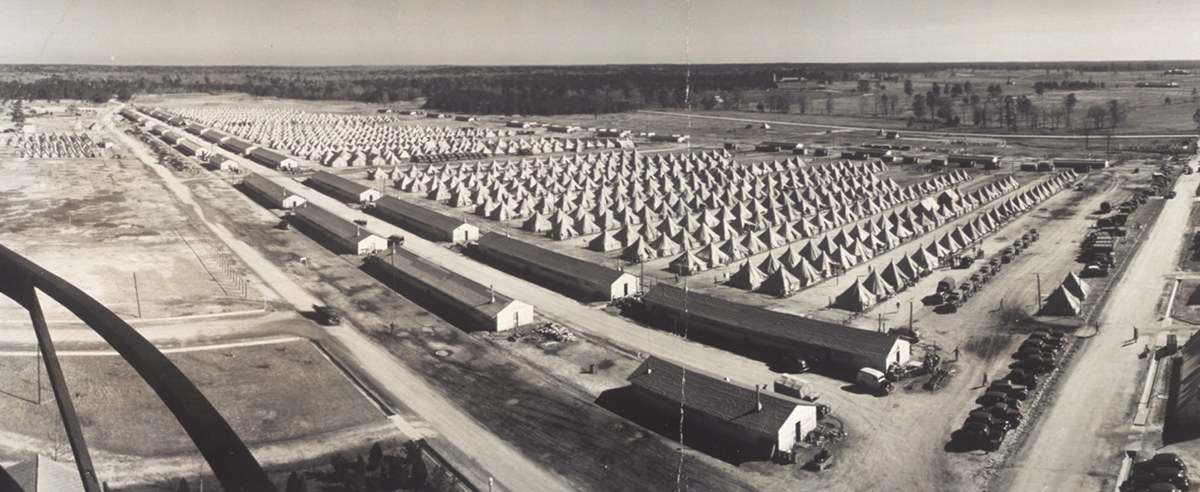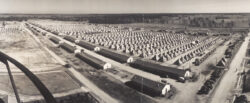Louisiana National Guard Training Center in Pineville (Camp Beauregard)
More than a century of existence makes Pineville’s Camp Beauregard, renamed the Louisiana National Guard Training Center in 2023, one of the oldest training camps in continuous operation in the nation.

Library of Congress Prints and Photographs Division
A panoramic photograph of Camp Beauregard, 1941.
The Louisiana National Guard Training Center in Pineville, originally named Camp Beauregard, prepared American soldiers for participation in World War I. The camp later served as an administrative center and work location for the Civilian Conservation Corps during the Great Depression and as a headquarters for the Louisiana Maneuvers during World War II. After the war it became a training center for the Louisiana National Guard.
Beginnings
Camp Beauregard’s origins lie in World War I. Despite the United States’ proclaimed neutrality at the beginning of the war, the German threat from submarines combined with British propaganda forced President Woodrow Wilson to ask Congress for a declaration of war against Germany on April 2, 1917. This was the first time American troops were committed to a foreign conflict in the country’s history.
Army commanders discovered that their forces did not have a system for developing and maintaining the reserve troops necessary to supplement regular ones while pursuing Mexican general Francisco “Pancho” Villa along the border during 1916 and early 1917. That realization led to the creation of a network of training camps, including Camp Beauregard, to address that problem after Congress declared war.
Local officials led by Alexandria engineer Ira Sylvester and others convinced Army decision-makers to locate a training facility in Pineville. The War Department followed a policy of naming facilities after regional military figures, so the camp was named for Confederate Gen. Pierre Gustave Toutant Beauregard.
Maj. Gen. Henry C. Hodges established his command at the post in July 1917 even as workers of Stewart and McGee Construction Company finished initial building projects. Camp Beauregard was designated for training National Guard troops from Alabama, Arkansas, Louisiana, and Mississippi. About forty-five thousand troops trained at the camp before the armistice took effect in November 1918.
The Army used Camp Beauregard as a demobilization center for American troops until abandoning it in March 1919 and selling much of Beauregard’s acreage during demobilization.
Interwar Years
The state retained enough land to host Louisiana National Guard summer training exercises beginning in 1921. National Guard units from Alabama and Mississippi also trained there during the 1920s, as did units of the US Marine Corps Reserve, and the camp became the storage depot for the Louisiana National Guard’s motor transportation unit.
The federal government obtained about eighty-six hundred acres in 1926 for a camp airport and a small arms and artillery firing range. The government spent about $70,000 (roughly $1.2 million in 2023 USD) for improvements between 1936 and 1938. Camp Beauregard ranked as one of the best National Guard training camps in the South by the late 1930s.
Camp Beauregard also became a Citizens’ Military Training Camp during summers from 1921 until 1940 to introduce young men to military life, military organization, management, discipline, instruction, athletics, recreation, and social contacts without any commitment to join the armed forces. Camp Beauregard was one of about fifty such camps nationwide and the only one in Louisiana.
Camp Beauregard supported the New Deal as the administrative center for District E, 4th Corps area as part of President Franklin Roosevelt’s Civilian Conservation Corps (CCC). CCC “boys” stationed at the camp completed numerous conservation projects in central Louisiana, and staff at the camp supervised fifty-seven other CCC camps in Louisiana and western Mississippi.
World War II
The blitzkrieg, or “lightning war,” that Germany launched against Poland on September 1, 1939, lead to the revitalization of Camp Beauregard. The Army reclaimed, enlarged, and improved Camp Beauregard in 1940 as part of its effort to create an effective military force in case the United States became involved in the European war.
Army officials announced plans in autumn of 1940 to construct three additional camps in the region: Camp Livingston and Camp Claiborne (near Forest Hill and Tioga respectively) in Rapides Parish and Camp Polk (near Leesville) in Vernon Parish. All three camps were operational by 1942. Construction of the Alexandria Army Air Field, the Pollock Army Air Field in southern Grant Parish, along with the earlier Camp Beauregard Airport in Rapides Parish, created a formidable military presence in the region.
Louisiana also hosted a series of training maneuvers that brought even more military presence into the area beginning in the spring of 1940. Camp Beauregard hosted and supported the series of Louisiana Maneuvers, including the 1941 Maneuvers, the largest peacetime training maneuvers conducted by the US Army.
Post-World War II
The Army deactivated Camp Beauregard again after the war ended. National Guard troops used the camp as an assembly point when they traveled to other training sites and as a summer training area.
The Rapides Parish Police Jury received Camp Beauregard’s airfield in 1953 for use as a civilian airport. That facility—named Esler Field in 1941 in honor of Lt. Wilmer Esler, a pilot killed in a training accident—served central Louisiana until 1996 when air service was moved to the former Alexandria Air Base (renamed England Air Force Base in honor of Lt. Col. John Brooke England, commander of the 389th Fighter Bomber Squadron killed while training in 1954). The National Guard now uses Esler Field as an aviation training and repair facility.
Camp Beauregard was fully reactivated in 1973 and is Louisiana’s largest National Guard training post as of 2023. It is also used for storage, maintenance, administrative, and other purposes. It is home to the Joint Operations Command, which responds to emergencies, the Youth Challenge Program, which assists young people in need, the Officer Candidate School in Louisiana, and other programs.
More than a century of existence makes Camp Beauregard, renamed in 2023 as the Louisiana National Guard Training Center in Pineville, one of the oldest training camps in continuous operation in the nation.
